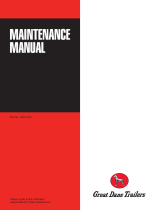
Operation (cont.)
- 3 -
To Open
To Close
1
To start using your new brake, rotate the lock-
ing handle (1) counterclockwise (toward you), to
open jaws.
2
Insert material into jaws, rotate locking handle
clockwise (away from you), until lightly clamped
in place. Align bend marks with the edge of the
stainless strip. Lock Brake.
3
With a solid grip on the bending handles, lift
bending hinge against material until desired angle
is made. If you are unsure, use a small piece of scrap
as a template.
Material Stops
Using Optional TrimCutter
™
Using Optional TrimFormer
™
Material Stops are used in pairs to allow for quick
bending without having to measure and mark each
piece of metal. To set stops, lock brake along your
initial marks. Loosen thumb screws and slide block up
against edge of material. Retighten thumb screws.
TrimCutter
™
will cut just about anything the brake
will bend. Lock material in place and place Trim-
Cutter
™
in tracks. With one steady motion, extend
TrimCutter
™
the full length of piece.
TrimFormer
™
was designed to use with lighter
gauge aluminum trim coil and is used to place con-
tours into trim work. Lock material in brake and
extend tool along piece. For a more pronounced
effect, extend tool along piece several times.
Adjusting Your Brake
1
Your new brake comes from the factory ready to bend. Due to normal wear, or when changing to a unique thickness of material, it may become necessary to
readjust the cam wedges to ensure uniform clamping/holding pressure. Cut 2" x 2" test squares from the material you intend to bend. Lock one square in place at
each casting. Try to pull each square out of the brake. Excessive movement at that point will require an adjustment of the wedge. Follow procedure below.
Adjusting (cont.) Care & Maintenance
2
To adjust, loosen wedge screw and move wedge
in direction of arrow 1/8". Retest and repeat if
necessary.
1
Keep clamping surfaces clean and free of debris.
Inspect hinge area each day before use. Ensure
hinge moves freely in slot.
2
Inspect hinge area daily for dirt, debris or metal
shavings. Ensure vinyl strip is free of excessive wear
or damage and replace as needed.
Key Features & Components - 2 -
P
lease take a moment to familiarize yourself with some of the components that will be referenced in the following steps. For further
clarication on a particular item, refer to the exploded parts list on page 4, or go online to: www.van-mark.com for tutorials, tips
and how-to’s. Note: Try bending scrap material until familiar with operation.
Example Compound Shapes
Outside Corner “W” Style Valley Pan Window Casing Inside Corner Ridge Cap
W
ith the added throat depth of this brake, bending more complex shapes is something you can now do on the job site. We recom-
mend making practice bends with scrap metal until satised with the results. Please read the following instructions, which will
guide you in keeping your investment in top working order.
Operation
Material Recommended
Model: Contractor Commercial
Aluminum .032 .040
Galv. Steel 26 ga. 24 ga.
Painted Steel Grade D 26 ga. 24 ga.
Copper 24 oz. 32 oz.
Zinc Alloy .032 .040
Stainless Steel 26 ga. 26 ga.
Note: The above capacities are based on standard metal properties. Please contact our
factory for capacities on your specic material.
B
ending Capacities. The above capacities are for general
use only as it would be impossible to list all the various
metal, alloys and their hardness. Contact your supplier for
specs on materials not listed above, or outside the range of
the above.
Legend
1 Locking Handle
2 Carrying Handle
3 Bending Handle
4 Casting
5 UniStand
™
USA2
(optional accessory)
6 Bending Hinge
7 Vinyl Strip
8 Cam Tube
9 Base Rail
10 Power Lock Bar
11 Cam Lock Assy.
12 Tape Rule







